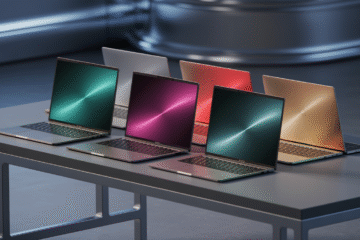Table of Contents
ToggleBest Laptops for Programming in 2025: A Practical Buyer’s Guide
Choosing the right laptop for coding isn’t just about raw speed—it’s about balance. Programmers need a machine that compiles quickly, handles dozens of browser tabs, runs containers or virtual machines when required, and still delivers all-day battery, a comfortable keyboard, and a glare-free, readable display. This guide breaks down what actually matters for developers in 2025 and then reviews five notable options—KAIGERR AX17, ASUS Vivobook 16, HP TPN-Q287, ASUS Zenbook DUO, and Lenovo V15—with clear recommendations based on use case.
What Programmers Should Prioritize
CPU: Fast Single-Core With Enough Cores
For most dev stacks (web, mobile, and general scripting), high single-thread performance keeps editors and tooling snappy, while 8+ efficient cores help parallel compiles, Docker builds, and test suites. Aim for a recent-gen Intel Core or AMD Ryzen H/U-series, or Apple Silicon if you’re in that ecosystem.
Memory (RAM): 16GB Minimum, 32GB Ideal
Modern IDEs, language servers, multiple containers, and a few Electron apps can easily exceed 12–14GB during a long workday. 16GB is the current floor; 32GB is recommended if you use Docker/Kubernetes, Android Studio, heavy data libraries, or multiple VMs.
Storage: NVMe SSD, 1TB Preferred
A 1TB NVMe SSD provides headroom for source trees, node_modules, Gradle caches, Docker layers, and offline datasets. If you’re budget-bound, 512GB works—but plan on good housekeeping or external storage.
Display: 16″ Class Sweet Spot, 1080p+ With Anti-Glare
A 15–16″ display reduces eye strain and accommodates two code panes + a terminal. IPS or OLED with anti-glare is ideal. Target 300+ nits brightness and good color accuracy if you also do UI/UX work.
Keyboard & Trackpad: Comfort Is a Feature
A tactile keyboard with sensible travel, full-size arrow keys, and consistent backlighting is indispensable. A precise trackpad with palm rejection saves time in meetings and on the go.
Battery & Thermals: Real-World Endurance
For untethered coding sessions, look for honest 7–10 hours mixed-use. Good thermal design avoids throttling under sustained compile or container workloads.
Ports & Connectivity: Fewer Dongles, More Focus
USB-C with PD charging, multiple USB-A for dongle-free peripherals, HDMI for conference rooms, and Wi-Fi 6/6E are baseline expectations. An SD/microSD reader is a bonus for embedded and media tasks.
The Shortlist: Who Each Laptop Is For
-
KAIGERR AX17 Laptop (17″) — Best for programmers who want a big canvas, multiple panes, and frequent local testing without an external monitor.
-
ASUS Vivobook 16 — The practical daily driver for general web/app development with strong value in a 16″ form factor.
-
HP TPN-Q287 — A corporate-leaning, dependable notebook code-friendly for office and hybrid work environments.
-
ASUS Zenbook DUO — The multitasker’s dream; dual displays supercharge context switching, docs side-by-side, and reference-driven coding.
-
Lenovo V15 — A budget-friendly entry point for beginners and students who want a reliable coding laptop without overspending.
5- KAIGERR AX17 Laptop — The Big-Screen Workhorse
Why It Stands Out
A 17-inch screen changes how you work: full-height file trees, a wide diff view, logs in a comfortable split terminal, and a dashboard all visible at once. If you spend long days coding or reviewing pull requests, the extra space reduces window juggling and fatigue.
Programming Experience
-
Editor Comfort: Spacious layout means fewer tabs and more side-by-side panes.
-
Builds & Tests: Expect room for heavy workloads; pair with at least 16GB RAM, ideally 32GB if you use multiple containers.
-
Thermal Headroom: Larger chassis typically helps sustained performance under compiles or when running local databases.
Where It Fits Best
-
Full-stack developers who keep Docker, PostgreSQL, message brokers, and frontend tooling running concurrently.
-
Engineers who want desktop-like comfort on the go.
Considerations
-
Larger footprint and weight.
-
Battery life may be shorter under load; plan for desk use with PD power.
4- ASUS Vivobook 16 Laptop — The Balanced Daily Driver
Why It Stands Out
The 16″ class is a sweet spot for devs—more screen than 15″, notably more usable than 14″, yet portable enough for a backpack. Vivobook lines are known for practical value: good keyboards, viable thermals, and useful I/O at reasonable prices.
Programming Experience
-
General Dev Stacks: Ideal for web development (Node, Python, PHP), mobile cross-platform frameworks, and compiled languages with moderate project sizes.
-
Memory & Storage: Configure to 16GB/512GB+ minimum; 1TB is recommended if you keep large caches and container images locally.
-
Display: IPS panels are common here; look for anti-glare and a 16:10 aspect ratio to gain vertical space for code.
Where It Fits Best
-
Students, junior to mid-level engineers, and freelancers who want an affordable, dependable daily machine.
-
Developers who need USB-A, USB-C, and HDMI without a bag full of dongles.
Considerations
-
Not designed as an ultraperformance laptop for heavy CUDA/ML training.
-
Color accuracy may be average—fine for coding, less ideal for pro-level color work.
3- HP TPN-Q287 Laptop — The Corporate-Ready Coder
(“TPN-Q287” is HP’s platform/model code commonly seen in enterprise configs; exact specs vary by region and SKU.)
Why It Stands Out
HP’s business-leaning builds emphasize stability, serviceability, and office-friendly ergonomics—great for developers working in managed IT environments or hybrid offices.
Programming Experience
-
Typing & Trackpad: Business lines tend to deliver comfortable keyboards and consistent pointing devices—underrated productivity boosters.
-
Security & Admin: Enterprise features like firmware protections, optional smart card or TPM integrations, and predictable driver support can matter in corporate settings.
-
Ports: Expect practical I/O for meeting rooms and docking.
Where It Fits Best
-
Developers in IT-managed teams who value reliability, compatibility with enterprise tools, and straightforward support.
-
Engineers working primarily with IDEs, databases, office suites, and standard dev toolchains.
Considerations
-
Depending on configuration, displays can be tuned for efficiency rather than premium color.
-
Ensure you spec 16GB+ RAM and fast NVMe to avoid bottlenecks.
2- ASUS Zenbook DUO Laptop — The Multitasker’s Power Tool
Why It Stands Out
The dual-display design is a genuine productivity advantage for programmers who live in split views: editor + terminal, code + docs, or IDE + browser devtools. It reduces context switching and keeps reference material persistent.
Programming Experience
-
Workflow Upgrades:
-
Keep API docs, Swagger/OpenAPI, or Jira on the lower display while coding up top.
-
Run a persistent terminal, logs, or Git diff below without covering your editor.
-
-
Performance: Configure with a recent Core/Ryzen and 32GB RAM if you’re a heavy multitasker with containers and emulators.
-
Portability: Still backpack-friendly while delivering a desktop-like layout anywhere.
Where It Fits Best
-
Frontend developers who constantly toggle between devtools and code.
-
Backend engineers monitoring logs or tracing while iterating.
-
Polyglot devs who keep docs open to maximize flow.
Considerations
-
The second screen changes palm rest and heat dynamics—give yourself a few days to adapt.
-
Battery life can dip if both panels run at high brightness; keep a USB-C charger handy.
1- Lenovo V15 Laptop — The Budget-Smart Starter
Why It Stands Out
The Lenovo V15 series is popular among students and new developers because it delivers a coding-ready platform at an approachable price. It’s not about flash—it’s about reliably running the tools you need to learn and ship code.
Programming Experience
-
Entry-Level Coding: Great for web basics (HTML/CSS/JS), Python, Java, lightweight Node projects, and command-line tooling.
-
Practical Specs: Prioritize SKUs with 16GB RAM and an NVMe SSD; even a modest CPU feels responsive with sufficient memory and fast storage.
-
Maintenance: Easy to keep clean and organized as a daily learning machine.
Where It Fits Best
-
Students, bootcamp learners, and early-career devs.
-
Secondary laptop for travel or meetups when you don’t want to carry a premium device.
Considerations
-
Displays are typically functional rather than premium; consider an external monitor at your desk.
-
Keep background apps lean to preserve responsiveness.
Programming Workflows These Laptops Handle Well
Web Development (React, Next.js, Django, Laravel)
All five options will run modern web stacks smoothly when configured with 16GB RAM and NVMe storage. For constant hot reloads and large monorepos, the Vivobook 16 and Zenbook DUO provide especially comfortable screens. The KAIGERR AX17 excels when you’re juggling dashboards, logs, and source panes at once.
Mobile Development (Android Studio, Flutter, React Native)
These tools are RAM-hungry, particularly emulators. Consider 32GB if budget allows. Zenbook DUO shines for keeping emulators/devtools visible alongside code; KAIGERR AX17 helps with multi-pane layouts and emulator windows.
Containers, Databases, and Local Services
If you spin up Docker Compose stacks with databases, queues, and services, prioritize CPU headroom and 32GB RAM. The KAIGERR AX17 handles sustained load well; Vivobook 16 is a strong all-rounder; HP TPN-Q287 is reliable in corporate dev setups.
Data & AI Prototyping (Lightweight)
For pandas/NumPy prototyping, these machines are fine, but serious model training benefits from workstation GPUs or cloud instances. Use these laptops as orchestration/EDA endpoints and offload heavy training to the cloud.
Recommended Configurations by Use Case
Best for Big Layouts & Local Services
-
Pick: KAIGERR AX17
-
Spec Target: 8-core recent CPU, 32GB RAM, 1TB NVMe, 17″ 1080p–1440p anti-glare, Wi-Fi 6/6E
Best All-Round Value
-
Pick: ASUS Vivobook 16
-
Spec Target: Recent Core/Ryzen, 16–32GB RAM, 1TB NVMe, 16:10 IPS 300+ nits, USB-C PD + HDMI
Best for Enterprise/Office
-
Pick: HP TPN-Q287
-
Spec Target: Business-grade CPU, 16–32GB RAM, 512GB–1TB NVMe, solid keyboard, enterprise security options
Best for Multitasking & Reference-Heavy Coding
-
Pick: ASUS Zenbook DUO
-
Spec Target: Recent Core/Ryzen, 32GB RAM, 1TB NVMe, tuned brightness on both displays, PD charger in bag
Best Budget Starter
-
Pick: Lenovo V15
-
Spec Target: 16GB RAM, 512GB NVMe (or 1TB if possible), IPS display option, keep background services minimal
Practical Setup Tips for Any Programming Laptop
Optimize Your Dev Environment
-
Use WSL2 (Windows) or native shells with oh-my-zsh/Starship for fast terminals.
-
Keep a lightweight Docker profile; prune old images and volumes regularly.
-
Adopt a dotfiles repo for consistent git, vim/nvim, and shell configs across machines.
Mind Your Battery & Health
-
Prefer an external monitor (24–27″, 1440p) at your desk to reduce eye strain and increase productivity.
-
Enable a battery health mode (60–80% limit) if you stay plugged in often.
-
Keep vents clean and elevate the rear during sustained compiles.
Backups & Versioning
-
Use Git remotes and cloud backups for critical code and notes.
-
Snapshot Docker volumes and databases before major dependency upgrades.
-
Keep a small USB-C SSD for offline backups when traveling.
Final Verdict
-
If you want a desktop-like coding canvas in a laptop, the KAIGERR AX17 is the easiest way to see more and juggle complex tasks locally.
-
For a balanced, cost-effective daily driver, the ASUS Vivobook 16 hits the sweet spot of screen size, portability, and configuration flexibility.
-
Working in a managed, corporate environment where reliability and security matter? The HP TPN-Q287 platform fits naturally into enterprise workflows.
-
If your productivity is tied to multitasking and constant reference material, the ASUS Zenbook DUO is a genuine upgrade that keeps docs, logs, and terminals visible without covering your editor.
-
Starting out or shopping on a student budget? The Lenovo V15 gets you coding today and leaves room to invest later in RAM, storage, or an external display.
Whichever you choose, prioritize 16–32GB RAM, a fast NVMe SSD, a comfortable keyboard, and a clear, anti-glare display. Those four choices will have more impact on your daily coding experience than any flashy spec sheet number—and they’ll keep you shipping clean, correct code faster, for longer.



0 Comments